It's considered Caribbean, though it's on the South American continent. It was first colonized by the Dutch, gained its independence from England, has a notable native population, yet the two largest populations are of (East) Indian and African descent. No doubt, Guyana — pronounced like the first names Guy and Anna together — is quite the blend of cultures, a study in miniature (the population's under one million) of many of the influences of the colonial age on the Americas. And as we've seen time and again, where cultures collide, so do their foods, so it's no surprise that Guyanese food has an intense Indian influence.
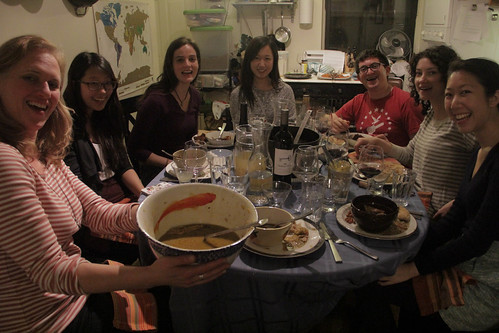
Joining us for this week's adventure: Rachel, Eunice, Sarah-Doe, Xindi, Erin, and Valerie! (Also, notice how we've finally put up our scratch-up map in our no-longer-very-new place.)
Limewash | Recipe
It's essentially the lime equivalent of a lemonade, but with small and awesome improvement: a splash of vanilla! That little bit of depth and perfume takes a bit of the edge off the sourness, while also complementing the floral notes of the lime. I also got a bit more depth by using demerara sugar — named after a former Dutch colony that's now part of present-day Guyana — which is a crystallized brown sugar, meaning it's got much of the minerally and tasty molasses from the cane. (You could use the similar, but more finely-grained, turbinado or "sugar in the raw" instead with the same result.) Goes great on its own, or with rum!
Tamarind balls | Recipe
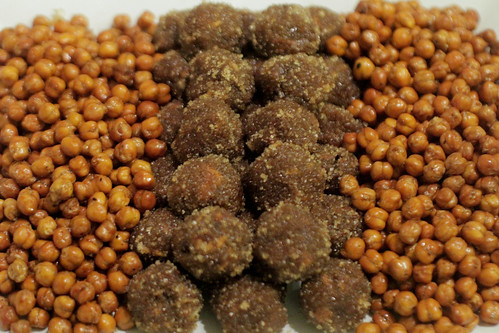
The word tamarind comes from the Arabic tamr hindi, meaning "date of India." They are indeed somewhat like dates in that they're a dark, rich, pitted fruit that grows on a tree and can last a good long while. But tamarind is a whole lot more tart. Sometimes it's used as a savory ingredient, such as in pad thai, and often it's sweetened up, when it's served as a juice. This recipe splits the difference, mixing a in whole lot of sugar (again I used demerara) but also raw garlic and chili, making for a puckery, sweet, intense flavor explosion. It's hard to eat too much of this at once, but even a small bite makes your mouth water, so it's an ideal amuse-bouche.
Fry channa | Crispy chickpeas | Recipe
After fry-tastic Haiti, I wasn't up for plunging more things in hot oil this week, and accordingly we missed out on a wide variety of Guyanese treats, notably a split-pea fritter called pholourie. While there's no way to fake a fritter, fortunately one of the several bloggers offers a fantastic substitute for another dish, fried chickpeas. It's really extremely simple, you just soak them overnight, drain and dry them, add a few spices and a tad of oil, and bake until crispy. In color and crunchiness, they're more than a little reminiscent of CornNuts — these aren't a snack to take along when you need to silently munch. But for a super-healthy and cheap snack that keeps quite a while and is a great pairing for beer or a cocktail, I'd recommend this.
Hassar curry | Recipe
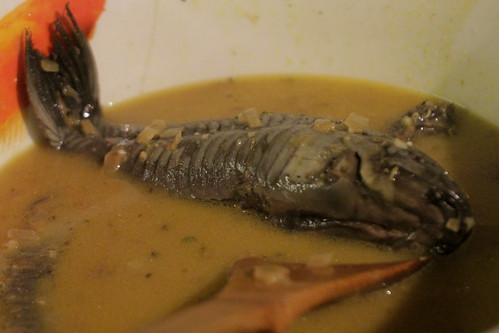
This dish is a perfect example of the blending of East Indian cooking techniques with West Indian ingredients. In this case, it's a coconut milk curry made with a respectable blend of spices you'd find in any respectable kitchen in the Subcontinent — turmeric, coriander, fenugreek, cinnamon, etc. — but the fish you'll find swimming in it is a novel one. The hassar is a catfish with an articulated shell, or what this recipe describes as an "underwater armadillo." If you don't live near a Guyanese or Trinidadian market you just won't find this fish, and while you could substitute with a catfish or tilapia, really so much of the wonder of this dish is the strangeness of the shell. The flesh itself is firmer than you'd expect for a medium-small fish, and pretty tasty although it likes to cling to the bone so it's a bit inconvenient. If you do find the fish, keep in mind that it's best served whole to each diner so they can attack it as they please, rather than trying to shell the fish before serving. Oh, also, serve it with rice to sop up all that curry; roti, as I tried, just didn't do the trick.
Pepperpot | Recipe
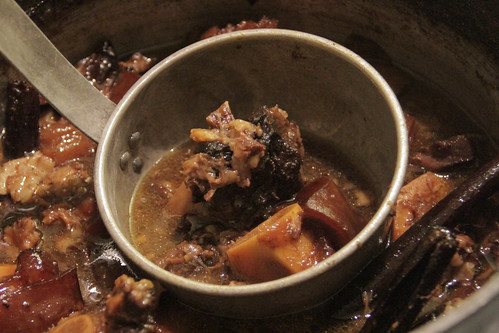
There are endless variations on Guyana's national dish — onions or no? one kind of meat, or a variety? is chicken reasonable or sacrilege? — the one point in common is cassareep. The product is as exotic as the name: extract of cassava, boiled with spices until it's turned thicker than molasses and about the same flavor as steak sauce, that somehow acts as a preservative that allows meat to stay for long periods at room temperature. If you can't find cassareep, then you can't make a Guyanese pepperpot. (If you can find cassava, you can make cassareep yourself, but I'll leave that as an exercise to the reader. Even I, an avid make-it-from-scratcher, bought this pre-made, as do most Guyanese.)
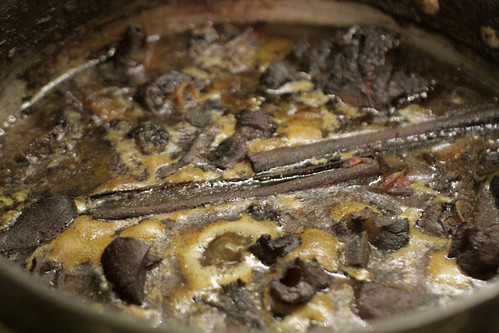
For meat, I went with ox tail, lamp chops, and cow feet, all cut into chunks. The recipe I followed is a more basic pepperpot, with little more than meat, spices, and cassareep. (I got the idea for pre-simmered cow feet, as well as to brown the meat, from another recipe, but that one called for onion and thyme and all sorts of fussier stuff.) I cooked it for maybe 3 or 4 hours on a low simmer the night before, left it out on the stove overnight, and re-simmered for about two hours before serving. The result was a rich, semi-sweet stew loaded with umami, that "sixth flavor" evoking protein-y meatiness. Not surprisingly, after all that cooking, the meat totally fell off the bone. I really enjoyed the flavor and texture, but due to the intensity I can't see myself craving this more than once ever few years.
Roti | Flaky flatbread | Recipe
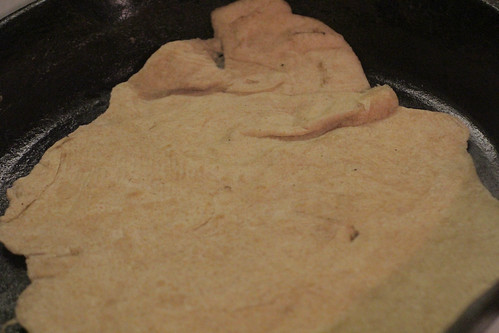
What the Guyanese call roti would be recognizable to a modern-day Indian as a paratha, made of a bunch of flaky layers, kind of like the croissant of flatbreads. The technique actually isn't as hard as I'd feared; it's worth scrubbing through the video in the recipe to see the hardest-to-describe part of the technique, where you take rolled-out dough, generously butter it, cut a line from the center to the edge, and then roll it up into a big cone before stuffing in the ends. Then, when you roll it out again, that's how you get all those layers. So clever.
Two things I did wrong. One, I used whole-wheat flour for half of this recipe. I went with that variation because the item that's called roti in India is made more often than not with whole wheat, but I think that both in terms of flavor and texture it didn't work, tasting kind of flat and not being flaky enough. The other was that neither of the dishes I made are actually made to go with roti — curry goes with rice and a pepperpot is traditionally served with a challah-like braided bread. Oh well, it was still fun to make!
Mango achar | Green mango pickle | Recipe
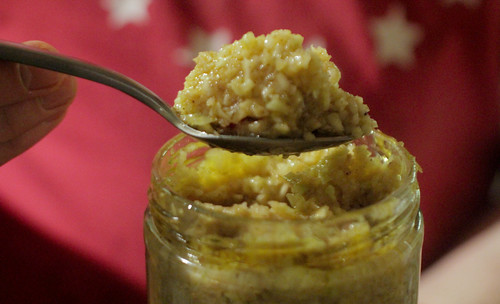
This is an all-purpose accompaniment to add tartness and spice to any dish. I went through all the motions, but just didn't start it early enough. It tasted too strongly of mustard oil and the spices hadn't yet pervaded, so if you feel the urge to make this, definitely give yourself a few days' head start.
Parsad | Milk and wheat dessert | Recipe

This name is slight variation on prasad, a Hindi word referring to food that is first offered in a religious ceremony and then eaten by people. In Guyana the term has been more narrowly applied to a specific dish of a sweetened and spiced milk and wheat porridge, kind of like a more aromatic cream of wheat. After the intensity of the flavors of the meal, this mild and soothing dish made for a satisfying conclusion.